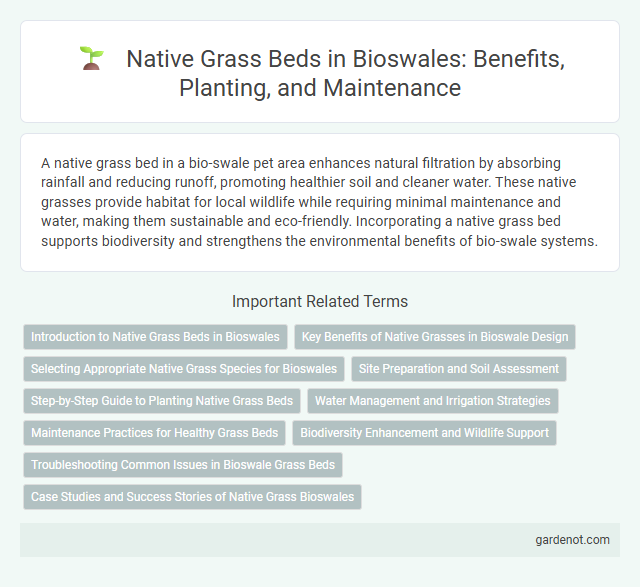A native grass bed in a bio-swale pet area enhances natural filtration by absorbing rainfall and reducing runoff, promoting healthier soil and cleaner water. These native grasses provide habitat for local wildlife while requiring minimal maintenance and water, making them sustainable and eco-friendly. Incorporating a native grass bed supports biodiversity and strengthens the environmental benefits of bio-swale systems.
Introduction to Native Grass Beds in Bioswales
Native grass beds in bioswales serve as essential components for stormwater management by enhancing water infiltration and pollutant filtration. These deep-rooted grasses stabilize soil, reduce erosion, and support microbial activity critical for breaking down contaminants. Their adaptation to local climates ensures lower maintenance and high resilience, making them sustainable solutions in urban green infrastructure.
Key Benefits of Native Grasses in Bioswale Design
Native grass beds in bioswale design enhance stormwater management by improving soil infiltration and reducing runoff volume. These grasses stabilize soil with deep root systems, preventing erosion and promoting pollutant filtration. Their adaptability to local climate conditions lowers maintenance costs while supporting biodiversity and habitat for pollinators.
Selecting Appropriate Native Grass Species for Bioswales
Selecting appropriate native grass species for bioswales ensures effective stormwater management by enhancing soil infiltration and reducing erosion. Species such as switchgrass (Panicum virgatum), little bluestem (Schizachyrium scoparium), and buffalo grass (Bouteloua dactyloides) are well-suited due to their deep root systems and adaptability to local climates. These grasses improve water filtration, support local biodiversity, and require minimal maintenance, making them ideal for sustainable bioswale design.
Site Preparation and Soil Assessment
Site preparation for a native grass bed in a bio-swale involves clearing existing vegetation and debris to ensure optimal soil contact and drainage. Conducting a comprehensive soil assessment, including pH, nutrient levels, and texture analysis, informs necessary soil amendments to promote healthy native grass growth. Proper soil aeration and grading are critical to prevent water pooling and support the bio-swale's stormwater infiltration function.
Step-by-Step Guide to Planting Native Grass Beds
Prepare the soil by removing weeds and loosening the top layer to promote root growth essential for native grass beds in bio-swales. Select native grass species suited to local climate and soil conditions, such as Little Bluestem or Switchgrass, to enhance water absorption and filtration. Plant seeds or plugs at recommended spacing, then mulch lightly to retain moisture and support early establishment of the bio-swale's natural filtration system.
Water Management and Irrigation Strategies
Native grass beds in bio-swales enhance water management by promoting natural infiltration and reducing runoff through deep root systems. These grasses improve soil permeability and support efficient irrigation strategies that minimize water waste and maintain soil moisture balance. Implementing native grass beds helps optimize stormwater retention while supporting sustainable landscape irrigation practices.
Maintenance Practices for Healthy Grass Beds
Regular mowing at appropriate heights encourages dense growth and prevents weed invasion in native grass beds within bio-swales. Seasonal removal of thatch and periodic overseeding with native grass species maintain soil health and promote resilience. Proper irrigation schedules that mimic natural rainfall patterns reduce water stress and support sustainable growth in bio-swale environments.
Biodiversity Enhancement and Wildlife Support
Native grass beds in bio-swales significantly enhance biodiversity by providing habitat and food sources for a variety of pollinators, birds, and small mammals. These grass species improve soil health and water infiltration while supporting diverse microbial communities critical for ecosystem resilience. The dense root systems of native grasses also stabilize soil, reduce erosion, and create a thriving environment for local wildlife populations.
Troubleshooting Common Issues in Bioswale Grass Beds
Troubleshooting common issues in bioswale native grass beds involves addressing poor drainage, soil compaction, and uneven plant growth. Ensuring proper soil permeability by aerating compacted soil and amending with organic matter enhances water infiltration and root development. Removing invasive species and selecting drought-tolerant native grasses like Little Bluestem or Switchgrass promotes healthy, resilient bioswale vegetation.
Case Studies and Success Stories of Native Grass Bioswales
Native grass bioswales have demonstrated significant success in urban stormwater management by improving water infiltration and reducing runoff pollutants. Case studies from cities like Seattle and Portland highlight how diverse native grass species, such as switchgrass and little bluestem, enhance soil stabilization and provide habitat for pollinators. These projects consistently show reductions in total suspended solids and nutrient loads, contributing to healthier watershed ecosystems.
Native grass bed Infographic

 gardenot.com
gardenot.com